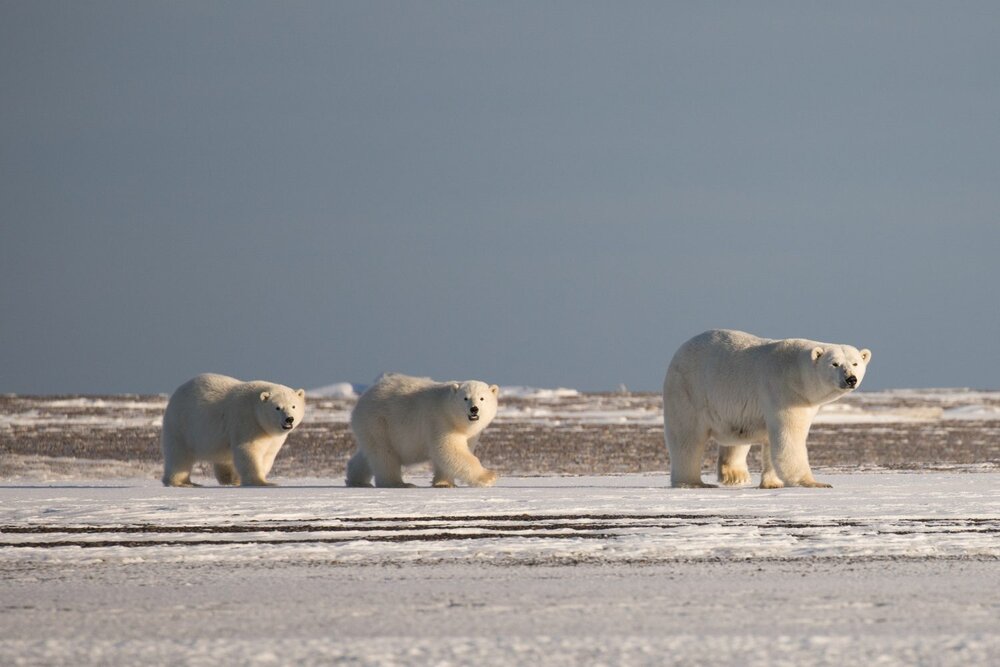Editor’s Note: In the Fight for Who We Love series, we introduce you to a species. These nonhuman species are what inspires most of us to join environmental movements and to continue to fight for the natural world. We hope you find this series inspiring, informative, and a break from news on industrial civilization. Let us know what you think in the comments! Also, if there is a species that you want us to cover in the upcoming months, please make suggestions. Today they are polar bears.
By Kim Olson and Benja Weller
When there’s talk about climate change affecting other species, people often think of polar bears. Because yes, their habitat is being destroyed — and we’ll get to that.
But the reason we’re writing about polar bears today is because long before I (Kim) knew anything about climate change or melting ice caps, they were my favorite wild animal. Because to me, they represent patience and intelligence, strength and resilience, playfulness and beauty.
FOOD + BEHAVIOR

A polar bear stretcheA polar bear stretches in Kaktovik, Alaska. Photo: Kim Olsons
Like much of the wild world (what’s left), polar bears must put in some serious effort and time to acquire their next meal, and as the largest terrestrial carnivorous mammal on earth, that’s no small amount.
So how much food do they need, then?
“Polar bears need to consume approximately 4.4lbs [2kg] of fat daily or a 121lbs [55kg] seal provides about 8 days’ worth of energy. Polar bears can eat 100lbs [45kg] of seal blubber in one sitting.”
A typical polar bear meal doesn’t vary a whole lot and includes one main course: seals (ringed, but also bearded, hooded and harped). But when food is scarce, they’re opportunistic eaters and will munch on berries, fish, plants, birds, small mammals — basically whatever they can find, which unfortunately also includes human garbage.
Hunting patiently on an ice sheet
While polar bears use their semi-webbed, big-ass paws (about 12in / 30cm, which is bigger than most human heads!) to wander the snowy ground and doggy paddle around the Arctic Ocean like nobody’s business, they aren’t aquatic animals. So they have to hunt usually at the edge of sea ice or next to a seal’s breathing hole.
Once the bears locate a suitable place to hunt, they get comfortable and prepare themselves for a potentially long wait. This most common " still-hunting” method, which they’re the most successful at, requires that the bears barely move for hours and sometimes even days.
Days! I don’t know about you, but I find that kind of commitment and patience remarkable. Because in an age where instant gratification is a thing, us civilized humans may sometimes feel it’s unbearable to have to wait longer than even thirty minutes for a meal when we’re hungry. But polar bears? They’ve got the patience thing down. I mean, they have to. Because, contrary to popular belief, food doesn’t actually come from the grocery store.
When not about to pounce on a seal, polar bears are generally slow-moving creatures, ambling leisurely and deliberately to conserve their strength. At times they may wander for miles, their huge paws helping to keep them from sinking too deeply into the snow.
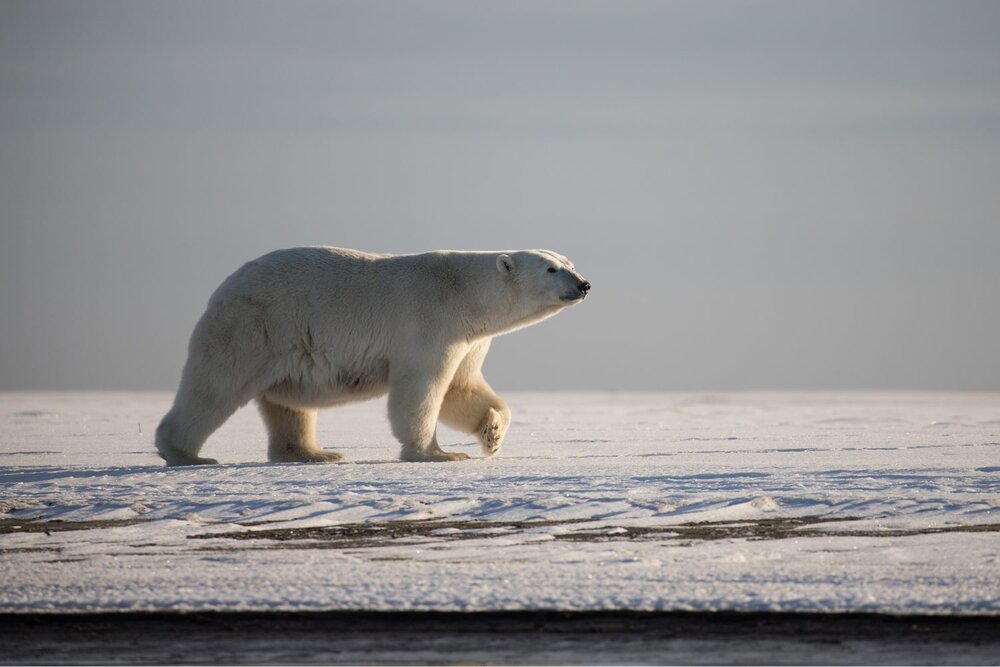
A bear walks across the snowy ground in Kaktovik, Alaska. Photo: Kim Olson
EVOLUTION + HABITAT
Harsh climate made polar bears become specialists
Polar bears diverged from brown bears but it’s not clear when — some estimates say a few hundred thousand years while newer guesses put it at a few million years.
But no matter when the split occurred, polar bears developed some unique characteristics that help them survive in a harsh climate where average winter temperatures are around -29°F / -2°C.
Most bears live north of the Arctic Circle in the US, Canada, Greenland, Norway, and Russia, and spend much of their lives on sea ice hunting (some sources say up to 50% of their time).
3 fun facts you may not know about polar bears:
- Their skin is black, which helps them absorb heat from the sun (when they have it, which is not much in the winter that far north!).
- Their fur (the thickest of all bears) is not white and is not actually hair. The outer layer of fur is in fact clear, hollow tubes. But because of the way these tubes reflect the visible light wavelengths, the fur appears white. And the hollow tubes provide insulation against the frigid temps and repel water.
- They don’t (typically) hibernate. Since their main food source (seals) is available only during the winter, only pregnant females hibernate (and in case you’re wondering, twins cubs are the most common), and even then it’s not a full hibernation like other bears do.
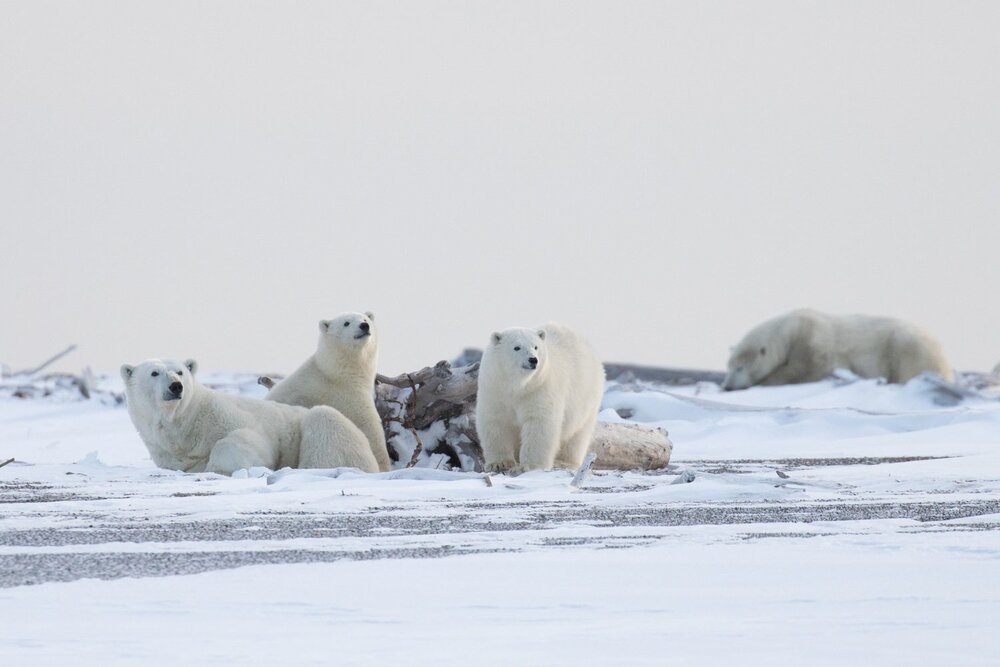
A mama bear with her two cubs in Kaktovik, Alaska. Photo: Kim Olson
QUICK STATS
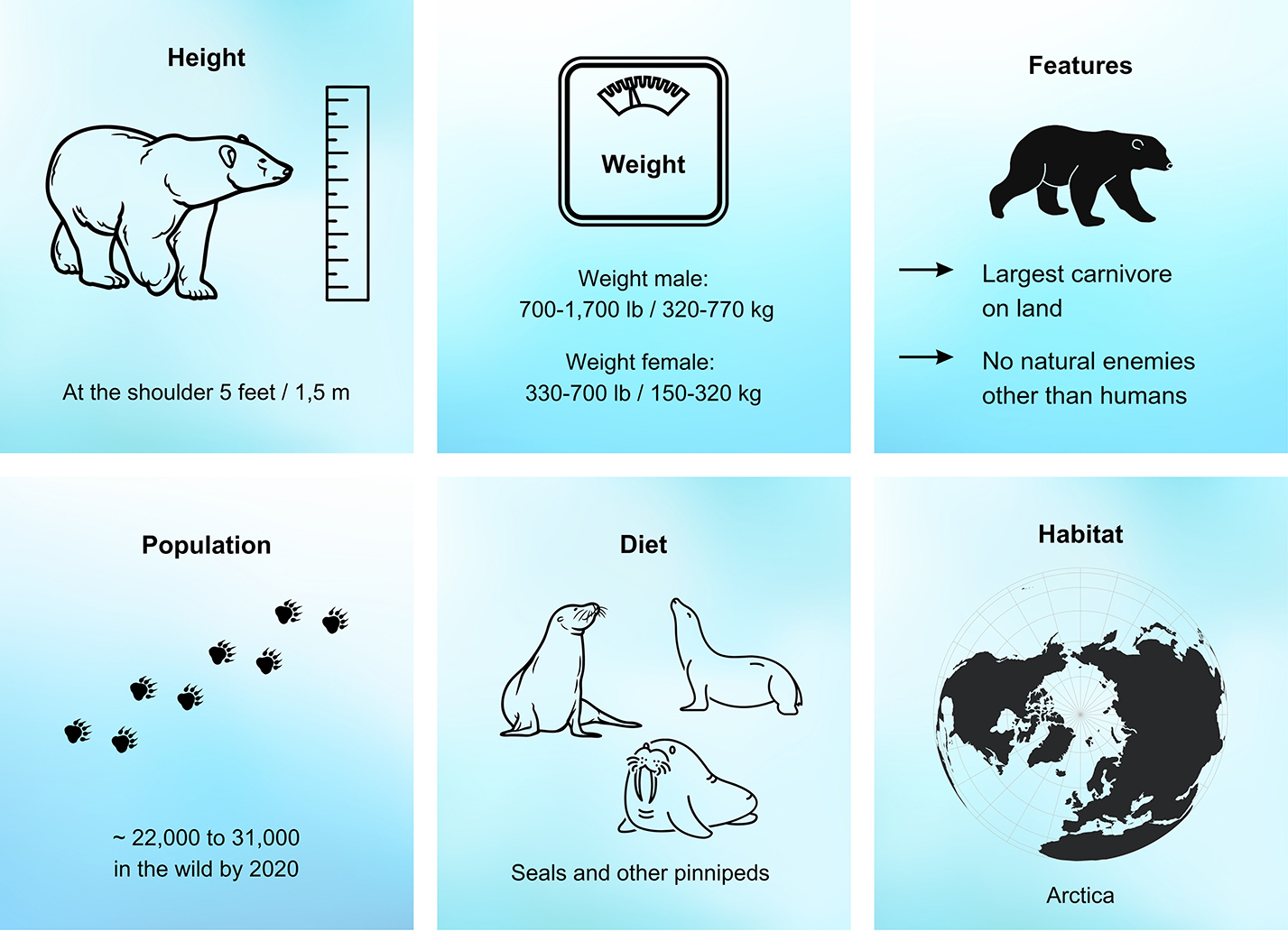
infographic about polar bears
Size: Males are about 2-3 times larger than females.
Length: 6-8’ [1.8-2.4m] females, 8-10’ [2.4-3m] males, 12" [.3m] newborn
Height: up to 5’ [1.5m] at shoulder on all four paws, 7-11’ [3.3m] standing upright
Weight: 300-700lb [136-318kg] females, 700-1700lb [318-771kg] male, 1-1.5lb [.5-.7kg] newborn
Paws: webbed paws up to ~12” [30cm] across, which makes them good paddles
Lifespan: 20-30 years in the wild
Running Speed: 25mph [40kph]
Swimming Speed: 6mph [10kph] for up to 62mi [100km] continuously
Walking Speed: 3.4mph [5.5kph]
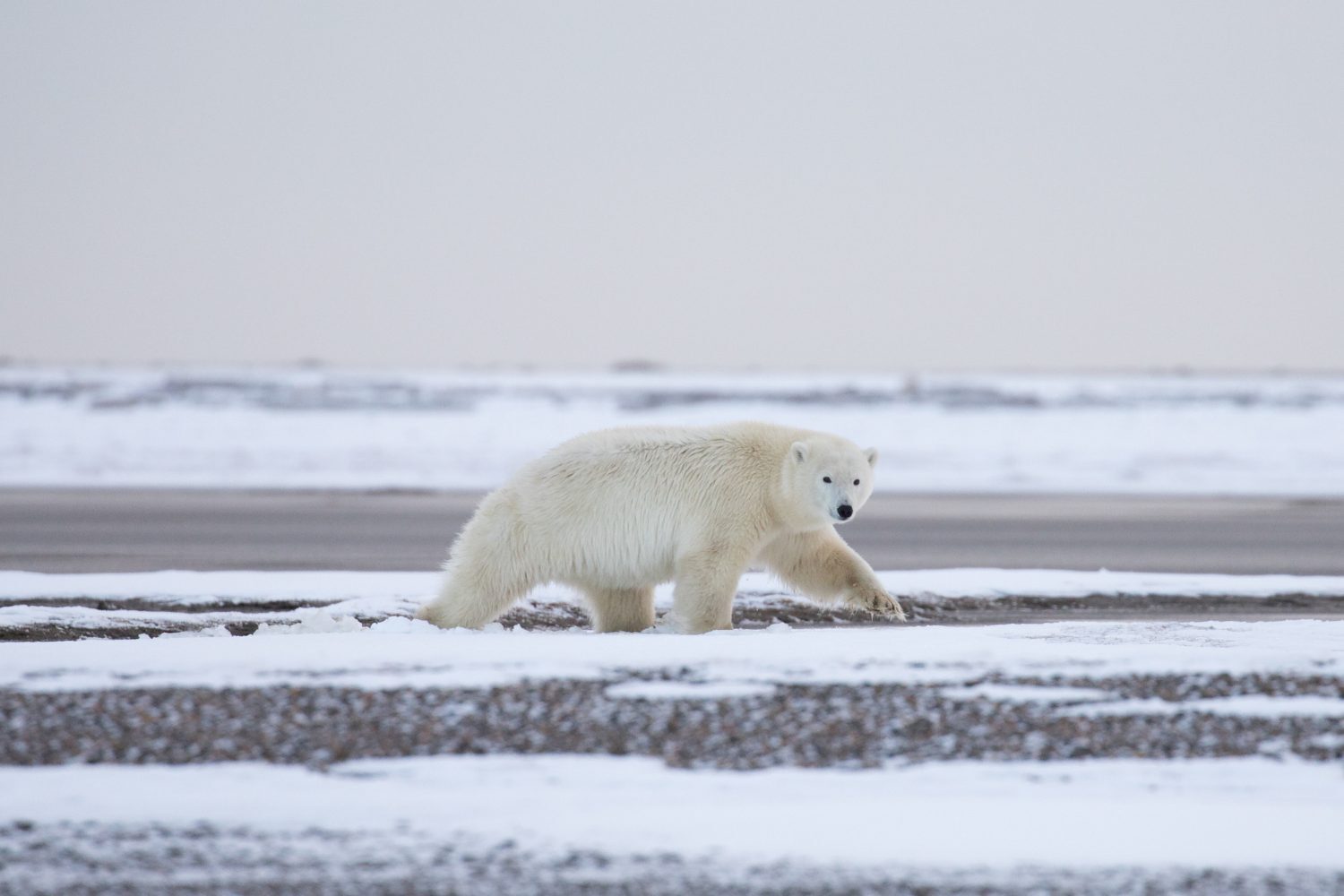
A solo polar bear walking in Kaktovik, Alaska. Photo: Kim Olson
THE BIGGEST THREAT
Melting ice sheets due to global warming
Most of us have seen pictures or videos of starving polar bears in the news. Skinny polar bears searching for food or sitting on an ice sheet with nothing around them but water are heart-wrenching to watch.
Photos and videos like those show the devastating effects of global warming, and are warning signs that express the conclusion in a BBC article by Helen Briggs and Victoria Grill: “Polar bears will be wiped out by the end of the century unless more is done to tackle climate change, a study (by Nature Climate Change) predicts.“
The single most important threat to the long-term survival of polar bears is loss of sea ice due to global warming, according to the International Union for Conservation of Nature. National Geographic writes about the bears in the Beaufort Sea region, who are among the best studied: “Their numbers have fallen 40 percent in the last ten years.”
Polar bear babies need fat
In our times of warmer climate, sea ice melts earlier in the spring and forms later in the autumn, forcing polar bears to walk or swim longer distances to the remaining ice sheets.
The second effect of melting sea ice is that the bears stay on land longer fasting and living off their fat stores. In both cases, the extra energy loss affects their ability to effectively reproduce and raise babies. When the mother is too skinny, a couple of problems arise:
Initially she can’t have as many babies as a healthy mom can. But when she does have cubs, they have a greater risk of dying by starvation due to the lack of fat in the mother’s milk. This can only mean that the entire population of polar bears decline.
Fossil fuel extraction in the Arctic
Pollution and the exploration of new oil and gas resources are also major threats to these white predators. As we’ve outlined in the article about Adélie penguins, there’s persistent organic pollutants (POPs) being moved from warmer areas to the cold Antarctic and Arctic.
If bears eat seals, they also consume POPs, and high levels of POPs rob polar bears of their vitamin A, thyroid hormones, and some antibodies which impairs their growth, reproduction, and the strength to fight off diseases.
Oil is toxic for animals in the Arctic
As easy-to-access oil and gas resources become scarcer, the industries explore in the most remote places to find this so-called " black gold." Unhinged, they try to exploit the beautiful Arctic, even though offshore oil operations pose a great risk to the polar bears.
When oil spills into the sea, it affects the bear’s fur, reducing its insulating effect. The bears unknowingly ingest the oil which can cause long-term liver and kidney damage, even if it’s a small amount. Oil spills can wipe out entire populations when they happen in places where there’s a high density of polar bear dens.
Despite sitting around most of the time, National Geographic says that these high-energy beasts can burn through 12,325 calories a day, which is equivalent to 40 (!) burgers.
The polar bears can’t just adapt to melting ice sheets and change their hunting methods in an instant — evolution doesn’t work like that.

Two polar bears play fight in Kaktovik, Alaska. Photo: Kim Olson
WHY THEY’RE SPECIAL
If you ask us, a world without the magnificent polar bears is a world worse off. So they are one more reason #whywefight.
FURTHER READING + SOURCES
- Polar Bear Facts by the US National Park Service, the National Wildlife Federation, PBS, Nat Geo Kids, World Wildlife Fund, Britannica
- Polar Bear Research from the Alaska Science Center
- Fasting season length sets temporal limits for global polar bear persistence
- Polar Bear Threats
- Polar Bears by Ian Stirling, Photographs by Dan Guravich
Featured Image: A female polar bear with her two cubs in Kaktovik, Alaska. Photo: Kim Olson
The 2023 DGR conference is scheduled for late August in northern California. This annual gathering is an opportunity for our community to share skills, reflect on our work, strengthen our connections, and plan for the future. While this conference is only open to DGR members, we do invite friends and allies on a case-by-case basis. If you’re interested in attending, please contact us, and if you’d like to donate to support the conference, click here.
